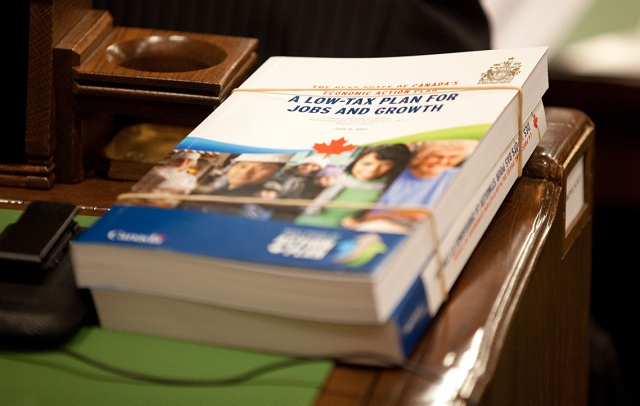You can change the economic conversation. Chip in to rabble’s donation drive today!
As Canada slogs through its anemic recovery, the federal government again appears to be happy to drive down growth. In fact since the last budget, economic growth for 2014 was revised down by a full point. The future two years out look rosy until we get there and then — surprise! — stagnant growth continues to be the norm.
The labour market, despite a whole booklet on it in the budget documents, is in much worse shape than advertised. Of the decline in the unemployment rate since the worst of 2009, 20 per cent was due to Canadians finding jobs, obviously a positive thing, but 80 per cent was due to Canadians giving up their search. In fact the situation is much worse for youth where 100 per cent of the drop in their unemployment rate was due to young people giving up their search.
Austerity bites
Half of all new spending announced in this budget is actually pre-existing funding, either because it’s a re-announcement or because they are carving out of other areas. While this budget has plenty of re-announcement of infrastructure projects, what hasn’t been a re-announcement is the tremendous cut in the operations budget. In fact 2014 will see us hit peak austerity of $14 billion cut out of program spending in that year alone. This will result in 26,000 full-time positions being cut since 2012, leading to much fewer people helping Canadians access federal services.
Previous budgets have kicked the cuts down the road — and now we’re at the end of the road and those cuts are being implemented. Stories abound of service cuts from veterans’ affairs to rail inspectors, to food inspectors and so on.
What is interesting in this year’s budget is that there is a recognition (although not stated explicitly) that these cuts have had serious impacts on service levels and need to be repealed. The Canada Food Inspection Agency in particular is seeing a partial reversal of the substantial cuts that were planned. According to last year’s Reports on Plans and Priorities, the CFIA was planning to cut 1,400 full-time positions. This year’s budget announces that 200 new people will be hired. In effect, this means that the cut will be only 1,200 by 2016 and not 1,400.
Cuts to Veterans Affairs offices have received substantial attention in recent weeks in part due to the disturbing trend of veteran suicides, three in January alone. However, there appears to be no reversal in this decision. An improved website, one of this year’s measures, will not stem the devastating tide of veteran suicides.
Electoral management, not economic management
The federal government is best placed to have a positive impact on the Canadian economy. Households have wracked up record debts, although they continue to spend. The provincial balances have been much harder hit than the feds. Corporate Canada for their part are sitting on plenty of cash, however, their policy seems to be “we’re right behind you.” They’ll start spending when someone else does. At this point the federal government has a record low debt burden. It’s also close to having a record low size (as a proportion of GDP). The federal government has substantially more fiscal room; it is unfortunate that it hasn’t chosen to use that room.
Youth employment has received plenty of attention from this government in advance of the budget. However there is nothing substantial to address this pressing issue. The only measure directed specifically at youth employment is the funding of 3,000 youth internships. Even with no deadweight loss, this would result in the youth unemployment rate declining from its present 13.9 per cent to 13.8 per cent. Hardly substantive action.
This budget, while it is being pitched as one of economic management, is really about electoral management. Next year will be an election year with next year’s budget being an election budget. It is only in 2015 that we’ll see the preferred policy measures of the federal government, likely income-splitting for families with children and the doubling of Tax-Free Savings Accounts. Both measures are targeted to the wealthiest households. In fact, the top 5 per cent of households would gain the same benefit as the bottom 60 per cent of the population. The implementation of this measure would exacerbate after-tax income inequality. The cuts that are being implemented in 2014 for veterans, the unemployed, food safety and so on are happening now to create fiscal room for tax cuts to wealthy households next year.
Burying the (bright) lead
Interestingly, the largest legitimately new spending program in this budget is for on-reserve K-12 students. Oddly, this is almost completely buried in other announcements.
In the past weeks, there has been a complete turn-around in the government position which used to be that there was no difference between on-reserve and provincial schools in terms of funding. There had previously been a 2 per cent cap on funding increases, irrespective of population change or need. That will be changed to 4.5 per cent. Combined with new capital funds for schools, it will start to improve the abysmal education system on reserves. The money won’t start flowing in earnest for three years, but the funding levels almost exactly match those called for in our Alternative Federal Budget as well from the Assembly of First Nations.
Unfortunately, the 2 per cent cap still exists in all other areas of on-reserve funding including social services, infrastructure, water/wastewater and university funding. The Alternative Federal Budget shows how the removal of this cap could dramatically improve the situation on reserve. What’s missing, as always, is political will.
David Macdonald is a Senior Economist with the Canadian Centre for Policy Alternatives. He attended the 2014 federal budget media lock-up.
Photo: pmwebphotos/flickr




